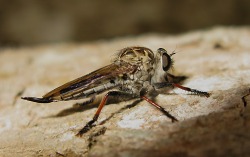Robber Fly

Robber fly, family Asilidae from Suriname
Robber flies are commonly seen sitting on a stem or leaf, often in sunny areas, seemingly minding their own business. But these true flies in the Asilidae family are in fact actively hunting for prey. And when something flies near (bees, beetles, flies, grasshoppers, dragonflies, etc.) they take off and grab it in mid-air with their strong legs.
They have a somewhat long life-cycle for a fly, averaging over one year and up to three years, from egg to the death of the adult. Once the egg hatches, the larvae goes through a variety of stages, mostly as a grub that lives in rotting vegetation, which is omnivorous and eats everything from dead plant material to other grubs. Finally, it pupates and becomes an adult fly.
And an interesting fly! After they take off and capture an insect, they use a strong and pointy proboscis (think like the pointy part of a mosquito that sucks our blood) to inject two harsh chemicals. The first is a neurotoxin to paralyze the insect, and the second is an enzyme that turns the insect’s insides to liquid, which the fly then drinks up through the proboscis like using a straw.
In general, other than a few robber flies that eat bees, these insects are considered highly beneficial as they help control agricultural pest insects. And no, robber flies do not bite people, like horseflies or deerflies do. But if you wish to actually grab one and pick it up, good luck, as they can nail you with a painful stab from that poisoned proboscis.
They have a somewhat long life-cycle for a fly, averaging over one year and up to three years, from egg to the death of the adult. Once the egg hatches, the larvae goes through a variety of stages, mostly as a grub that lives in rotting vegetation, which is omnivorous and eats everything from dead plant material to other grubs. Finally, it pupates and becomes an adult fly.
And an interesting fly! After they take off and capture an insect, they use a strong and pointy proboscis (think like the pointy part of a mosquito that sucks our blood) to inject two harsh chemicals. The first is a neurotoxin to paralyze the insect, and the second is an enzyme that turns the insect’s insides to liquid, which the fly then drinks up through the proboscis like using a straw.
In general, other than a few robber flies that eat bees, these insects are considered highly beneficial as they help control agricultural pest insects. And no, robber flies do not bite people, like horseflies or deerflies do. But if you wish to actually grab one and pick it up, good luck, as they can nail you with a painful stab from that poisoned proboscis.